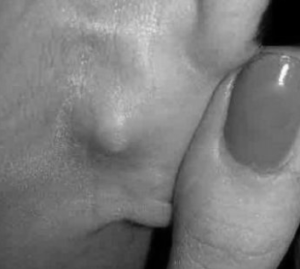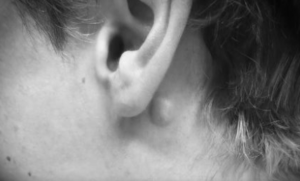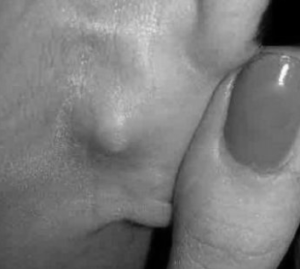A cyst behind ear can be more scary than dangerous. What causes a lump behind your ear? What are the symptoms like of a painful and recurring cyst behind your ear? In this post, we have covered comprehensive detail on the causes, symptom and how to remove a zit behind child’s ear.

A lump or bump behind the ear can be harmless. However, it may be a signal of a serious health problem that requires medication, as in the case of an infection. In most cases, they are not as dangerous or life threatening.
What is a cyst behind the ear? This is a common type of a sebaceous cyst seen in the ear that appear like sack-like lumps usually made up of dead skin cells and oils produced by the skin from the oil glands. The exact cause of cysts in the ear is still unknown but can appear anywhere including: behind the ear, in the ear, in the earlobe and on the scalp.
Symptoms
What are the symptoms of a cyst behind ear? If you have a cyst behind the ear, the symptoms would include:
- Pain from an infected cyst,
- Small soft lumps behind the ear
- Pimple like or bump particularly if you have a history with acne
- Fever or chills for more serious infection of the cyst
How do you detect you have a lump behind your ears. It is easier to tell a lump or a bump if you occasionally suffer from acne. For other normal people, sometimes figuring out if they have a cyst or zit behind the ear is actually hard.
How do you self –check? It is natural instinct to use your hands as the best tool to figure out a bump behind your ears. Does it feel soft to touch? Is it painful or hurt when touched? It can take the form of a pimple or an abscess.
In addition, if the lump hurts when and you end up with fever or chills, this can be a case of an infected cyst behind your ears.
If the bumps turn out to be problematic causing pain and or sometimes bleed coupled with other symptoms, visit your healthcare provider. Physical tests carried out by the doctor can tell what might be happening behind your ear.
Pictures
How does a cyst behind the ear look or appear like? As discussed earlier from the symptoms, if you have a lump or bump behind your ear that is soft to touch, that simply tells you have a cyst. In some instances, depending on the cause, the cyst can be hard and painful when touched. A bump that keeps on recurring is an indication of either an infection or a serious health condition that requires urgent treatment.
To help you understand how a cyst behind ear look or appear like, we have pictures and images that gives deeper illustrations. In addition, we have added more photos and videos to you identify well with your symptoms.


Possible Causes:
Although lumps behind your ear may not cause any life threatening risk, they should not be ignored. The cyst behind your ear can be caused by allergies, infections, bone tumors or cancer. Below are some of the conditions and factors that can lead to the growth of bumps behind your ears. Also included are details of the recommended treatments for each condition.
1. Is cyst behind you a sign of ear cancer?
Although the cyst behind the ear might not be painful, it could signify a more complicated health problem such as cancer. Salivary gland cancer and or skin cancer tend to grow as malignant cells behind the ear.
Cancer is a more serious condition that requires quick remedy as soon as it is detected. Common symptoms of head and neck cancer are manifested as cyst or bumps behind the ear. If you have a difficulty in swallowing associated with a sore throat that does not heal, it could be a signal of salivary gland cancer.
Swollen lymph nodes start as bumps in the back of your ear, this can be a sign of leukemia and lymphoma: a form of cancer that present itself as swollen lymph nodes.
2. Sebaceous cyst
A small cyst behind the ear can be caused by non- cancerous lumps that tend to rise beneath the skin. Sebaceous or epidermoid cysts are often painless and tend to cause no problem at all such that they do not warrant any treatment. However, if the cyst appears to bother you or it’s painful, you may choose to have it removed through a surgical procedure.

Sebaceous cyst appear as a small, round bump under the skin most predominantly on the face, trunk or neck and behind the ear. The cause of sebaceous cyst occurs when cells move deeper into your skin and tend to increase in number rather than sloughing off. In the process, the cells produce keratin: a thick yellow fluid that drains into the cyst behind the ear.
If you have a damaged hair follicle or oil gland, the abnormal multiplication of cells is linked as the cause, this consequently forms a cyst behind your ear. If the sebaceous cyst is infected, it will develop into abscesses causing a severe inflammation. This will necessitate medical treatment since the cyst is pus filled, smelly and painful.
3. Dermatitis
Another possible cause of a cyst behind your ear could be dermatitis. This is a buildup of waxy dead cells or dry skin that usually accompanies with infection or inflammation and redness. Although common in male than women and teenagers, the cause of dermatitis is still unclear. It could be a genetic disorder and tends to be active with a slightly low temperatures.
It can be linked to people with high level of stress, climatic changes and or infection particularly yeast. People suffering from Parkinson’s disease, AIDS or epileptic are prone to have seborrheic type of dermatitis that occurs as bumps behind the ear.
4. Mastoiditis
A lump behind the ear can occur as a result of infection in the mastoid bone. It is a condition commonly in children and tends to spread to the mastoid bone found at the back of your ear. The symptoms include protruding swelling presenting either small or large pimple like sacks. If you have mastoiditis, the infected bumps behind the ear is associated with fever, ear pain and redness.
If left untreated, possible serious problem can occur including hearing loss or impairment. Treatment involves use of intravenous antibiotics to help drainage of the fluid filled in the cyst.
5. Abscess
A cyst or zit behind the ear can be formed when cells or tissues behind your ear get infected. This is typically an abscess, to fight the infection your body responds by sending numerous white blood cells. As result of white blood cells accumulation in the damaged location, a cyst is formed. Pus forms from the damaged white blood cells, dead tissue, bacteria and other foreign substance.
The infected cyst feels warm and hurts when touched. Treatment involves use of oral antibiotics such as ceftriaxone to drain the pus.
6. Swollen Lymph Nodes
Bacterial or viral infection around the ear can lead to swelling of lymph nodes behind the ear. Small and soft bumps sometime painful when touched appear behind the ear, this can be accompanied by fatigue and or fever.
If you have a cold/flu, strep throat or sinusitis, your lymph nodes behind the ear and cheeks tend to swell. Infection stimulates the body to produce more white blood cells to fight infection.
7. Acne Vulgaris
Commonly referred to as Acne: it is a skin condition that is caused by clogged hair follicles in the skin. As a results of blocked pores of the hair follicles and skin, dead skin cells and oil will collect and form a bump or pimple. In some cases, the bumps can get infected making the cysts to grow to a bigger solid and painful cyst behind the ear.
8. Otitis Media
Any ear infection such as otitis media can cause you to have painful swelling fluid filled behind the ear. If you have a bacterial of viral infection, the possible symptoms include visible small bumps around the ear and sometimes tend to spread towards behind the ear.
Small painful cyst behind ear
Do you have a small painful cyst behind your ear? Majority of bumps behind the ear are nothing to cause you any worry. However, if the cyst is painful or hurts when touched, it could mean you have an infection that requires medical attention. In addition, rare cases of life threatening conditions are associated to bumps or nodules behind the ears.
Lumps behind the ear caused by infection or inflammation are usually temporary as the body responds to fight the infection. Bumps located behind the ear will resolve on their own with time. However, if you find complications, visit a doctor for examination and treatment.
Cyst behind ear smells
Does cyst behind your ear smells? As explained earlier, when the pores of the skin become clogged, oil secreted by the sebaceous glands tend to collect and develop into a bump. In case the cyst gets infected they start to produce a foul smell.
Infected cyst behind the ear will trigger the body to produce white blood cells to fight the infection. The bad smell from the bumps behind ear is a result of dead cells, pus, excess oil and other foreign substances. Treatment involves use of antibiotics to help drain the bump.
Cyst behind ear lobe
A cyst behind the ear lobe appear as a small and hard bump or lump like in the ear lobe or behind the ear. Most of the cyst in the earlobe are typical sebaceous cyst: a sack formed beneath the skin filled with pus, blood and dead white blood cells. The cyst behind or located in the earlobe can be mild, moderate or severe depending on the level of infection, pain and size.
Cyst behind child’s ear
If your child has a cyst behind the ear, it shouldn’t bother you. A cyst behind the ear of an infant can send a parent into shivers and panic. A pea-sized bump behind the ear of an infant is nothing to worry about. Some of these cysts are congenital (present at birth) and go the whole life of a child without any problem.
If the cyst become infected, it may be painful for the child to bear. Such cyst can be removed through a surgical procedure after the doctor examines it.
Recurring cyst behind ear
Is a cyst behind your keeps coming back after healing? A recurring cyst behind ear could mean a serious health risk or probably a mere infection. If the cyst behind your ear keeps on coming back month or years after healing, you need to see a doctor to have it evaluated and correctly diagnosed.
Cyst behind ear after piercing
If you have a cyst behind your ear after ear piercing, it simply tells you have an infection. Ear piercing are prone to get bumps or cyst but that shouldn’t worry you much. Swelling around the piercing is normal after 48 hours. However, if the cyst lasts for long, this probably tells that there is an infection in the piercing.
This necessitate the urge to see a doctor to diagnose and treat the infection. You can apply topical ointment twice daily to reduce the swelling and pain.
Popping a cyst behind the ear
Normally, whenever there is a bump or pimple on any part of the body, there is that urge to pop it with a needle or squeezing it. A cyst behind ear should not be popped or squeezed, instead visit a doctor for diagnosis and treatment. Sebaceous cysts are not a serious health risk and will resolve on their own with time.
However, if you try to squeeze or pop a bump behind the ear, you increase the risk of infection and scarring. This delays the healing process and can be painful.
Cyst behind ear treatment
A bump or nodule behind the ear can be left alone if it doesn’t cause any discomfort or health problem. However, if the cyst behind the ear becomes problematic you will need to seek treatment. Here are some of the recommended diagnosis and drugs:
1. Injection
If the cyst behind ear is infected, your doctor will recommend an injection to reduce swelling and inflammation.
2. Incision and drainage
If the cyst is large with blood and pus filled, your doctor will have to drain the cyst to speed the healing process. With this method, a small cut is made in the cyst and the content squeezed gently. It is actually fast but the cyst tend to often recur.
3. Removal by surgery
The entire cyst behind the ear can be removed, this is done if the cyst has a history of infection and keeps on coming back. A minor surgery is done to get rid of the cyst, it is considered as safe and effective way of removing a stubborn cyst.
4. Laser
Another faster way of removing a cyst behind your ear is by use of laser method. It basically involves use of carbon dioxide laser to vaporize the bump. This method minimizes scarring.
How to remove cyst behind ear-home remedies
A nodule or bump behind your ear that doesn’t cause any harm and or is not life threatening can be removed naturally at home. Here are some of the home remedies to help remove cyst behind the ear.
1. Warm compress
Warm compress the sebaceous cyst to speed up the healing process. A little warmth helps to drain the cyst fast and reduce swelling. Here’s how to remove the cyst:
- Use a piece of clean towel or cloth
- Soak the towel in warm water
- Apply/compress the warm towel onto the cyst for about 10 – 15 minutes
- Repeat the procedure above at least twice daily
2. Aloe Vera
Aloe Vera is popularly known for its skin benefits and generally as a medicinal plant that is good for your health. Aloe Vera has anti-inflammatory and anti – bacterial properties that helps to relieve pain and reduce inflammation. Here’s how to use aloe Vera to remove cyst behind ear.
- Get gel from fresh cut aloe Vera plant
- Apply the gel directly to the cyst
- Rub gently on the area to help it penetrate deep into the infected cyst
- Do this twice daily for effective result.
3. Apple Cider Vinegar to Remove Cyst
Apple cider vinegar is a natural home remedy that has anti – bacterial, anti – fungal and antiseptic properties. It can be used at home to cleanse infected cyst behind your ear. Here’s how to use apple cider vinegar to remove nodules behind the ear.
- Soak cotton balls in apple cider vinegar
- Gently apply onto your cyst for some time
- Do this daily at least 2 – 3 times
A Video showing How to Remove Cyst behind Ear.
Sources and references
- http://www.healthline.com/health/causes-lumps-behind-ears – Self-Checking3
- https://www.nlm.nih.gov/medlineplus/ency/article/001033.htm
- http://www.cancer.gov/types/head-and-neck/patient/salivary-gland-treatment-pdq
- Sebaceous cyst:http://www.mayoclinic.org/diseases-conditions/sebaceous-cysts/basics/complications/con-20031599
- Cysts, Lumps, Bumps, and Your Skin:http://www.webmd.com/skin-problems-and-treatments/guide/cysts-lumps-bumps?page=2


